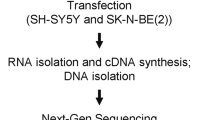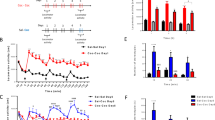Abstract
Regulated activity of SLC6A3, which encodes the human dopamine transporter (DAT), contributes to diseases such as substance abuse disorders (SUDs); however, the exact transcription mechanism remains poorly understood. Here, we used a common genetic variant of the gene, intron 1 DNP1B sequence, as bait to screen and clone a new transcriptional activity, AZI23′UTR, for SLC6A3. AZI23′UTR is a 3′ untranslated region (3′UTR) of the human 5-Azacytidine Induced 2 gene (AZI2) but appeared to be transcribed independently of AZI2. Found to be present in both human cell nuclei and dopamine neurons, this RNA was shown to downregulate promoter activity through a variant-dependent mechanism in vitro. Both reduced RNA density ratio of AZI23′UTR/AZI2 and increased DAT mRNA levels were found in ethanol-naive alcohol-preferring rats. Secondary analysis of dbGaP GWAS datasets (Genome-Wide Association Studies based on the database of Genotypes and Phenotypes) revealed significant interactions between regions upstream of AZI23′UTR and SLC6A3 in SUDs. Jointly, our data suggest that AZI23′UTR confers variant-dependent transcriptional regulation of SLC6A3, a potential risk factor for SUDs.





Similar content being viewed by others
References
Girault JA, Greengard P (2004) The neurobiology of dopamine signaling. Arch Neurol 61(5):641–644. https://doi.org/10.1001/archneur.61.5.641
Rosen ZB, Cheung S, Siegelbaum SA (2015) Midbrain dopamine neurons bidirectionally regulate CA3-CA1 synaptic drive. Nat Neurosci 18(12):1763–1771. https://doi.org/10.1038/nn.4152
Howe MW, Tierney PL, Sandberg SG, Phillips PE, Graybiel AM (2013) Prolonged dopamine signalling in striatum signals proximity and value of distant rewards. Nature 500(7464):575–579. https://doi.org/10.1038/nature12475
Perry CJ, Baciadonna L, Chittka L (2016) Unexpected rewards induce dopamine-dependent positive emotion-like state changes in bumblebees. Science (New York, NY) 353(6307):1529–1531. https://doi.org/10.1126/science.aaf4454
Gadagkar V, Puzerey PA, Chen R, Baird-Daniel E, Farhang AR, Goldberg JH (2016) Dopamine neurons encode performance error in singing birds. Science (New York, NY) 354(6317):1278–1282. https://doi.org/10.1126/science.aah6837
Vaughan RA, Foster JD (2013) Mechanisms of dopamine transporter regulation in normal and disease states. Trends Pharmacol Sci 34(9):489–496. https://doi.org/10.1016/j.tips.2013.07.005
Calipari ES, Juarez B, Morel C, Walker DM, Cahill ME, Ribeiro E, Roman-Ortiz C, Ramakrishnan C et al (2017) Dopaminergic dynamics underlying sex-specific cocaine reward. Nat Commun 8:13877. https://doi.org/10.1038/ncomms13877
Wang KH, Penmatsa A, Gouaux E (2015) Neurotransmitter and psychostimulant recognition by the dopamine transporter. Nature 521(7552):322–327. https://doi.org/10.1038/nature14431
Volkow ND, Wang GJ, Fischman MW, Foltin RW, Fowler JS, Abumrad NN, Vitkun S, Logan J et al (1997) Relationship between subjective effects of cocaine and dopamine transporter occupancy. Nature 386(6627):827–830. https://doi.org/10.1038/386827a0
Tiihonen J, Kuikka J, Bergstrom K, Hakola P, Karhu J, Ryynanen OP, Fohr J (1995) Altered striatal dopamine re-uptake site densities in habitually violent and non-violent alcoholics. Nat Med 1(7):654–657
Faraone SV, Spencer TJ, Madras BK, Zhang-James Y, Biederman J (2014) Functional effects of dopamine transporter gene genotypes on in vivo dopamine transporter functioning: a meta-analysis. Mol Psychiatry 19(8):880–889. https://doi.org/10.1038/mp.2013.126
van der Voet M, Harich B, Franke B, Schenck A (2016) ADHD-associated dopamine transporter, latrophilin and neurofibromin share a dopamine-related locomotor signature in Drosophila. Mol Psychiatry 21(4):565–573. https://doi.org/10.1038/mp.2015.55
Hamilton PJ, Campbell NG, Sharma S, Erreger K, Herborg Hansen F, Saunders C, Belovich AN, Sahai MA et al (2013) De novo mutation in the dopamine transporter gene associates dopamine dysfunction with autism spectrum disorder. Mol Psychiatry 18(12):1315–1323. https://doi.org/10.1038/mp.2013.102
Kurian MA, Zhen J, Cheng SY, Li Y, Mordekar SR, Jardine P, Morgan NV, Meyer E et al (2009) Homozygous loss-of-function mutations in the gene encoding the dopamine transporter are associated with infantile parkinsonism-dystonia. J Clin Invest 119(6):1595–1603. https://doi.org/10.1172/jci39060
Kurian MA, Li Y, Zhen J, Meyer E, Hai N, Christen HJ, Hoffmann GF, Jardine P et al (2011) Clinical and molecular characterisation of hereditary dopamine transporter deficiency syndrome: an observational cohort and experimental study. Lancet Neurol 10(1):54–62. https://doi.org/10.1016/s1474-4422(10)70269-6
Auton A, Brooks LD, Durbin RM, Garrison EP, Kang HM, Korbel JO, Marchini JL, McCarthy S et al (2015) A global reference for human genetic variation. Nature 526(7571):68–74. https://doi.org/10.1038/nature15393
Sudmant PH, Rausch T, Gardner EJ, Handsaker RE, Abyzov A, Huddleston J, Zhang Y, Ye K et al (2015) An integrated map of structural variation in 2,504 human genomes. Nature 526(7571):75–81. https://doi.org/10.1038/nature15394
Bannon MJ, Pruetz B, Manning-Bog AB, Whitty CJ, Michelhaugh SK, Sacchetti P, Granneman JG, Mash DC et al (2002) Decreased expression of the transcription factor NURR1 in dopamine neurons of cocaine abusers. Proc Natl Acad Sci U S A 99(9):6382–6385. https://doi.org/10.1073/pnas.092654299
Wang J, Bannon MJ (2005) Sp1 and Sp3 activate transcription of the human dopamine transporter gene. J Neurochem 93(2):474–482. https://doi.org/10.1111/j.1471-4159.2005.03051.x
Jacobs FM, van der Linden AJ, Wang Y, von Oerthel L, Sul HS, Burbach JP, Smidt MP (2009) Identification of Dlk1, Ptpru and Klhl1 as novel Nurr1 target genes in meso-diencephalic dopamine neurons. Development (Cambridge, England) 136(14):2363–2373. https://doi.org/10.1242/dev.037556
Kanno K, Ishiura S (2011) Differential effects of the HESR/HEY transcription factor family on dopamine transporter reporter gene expression via variable number of tandem repeats. J Neurosci Res 89(4):562–575. https://doi.org/10.1002/jnr.22593
Hwang DY, Hong S, Jeong JW, Choi S, Kim H, Kim J, Kim KS (2009) Vesicular monoamine transporter 2 and dopamine transporter are molecular targets of Pitx3 in the ventral midbrain dopamine neurons. J Neurochem 111(5):1202–1212. https://doi.org/10.1111/j.1471-4159.2009.06404.x
Jankovic J, Chen S, Le WD (2005) The role of Nurr1 in the development of dopaminergic neurons and Parkinson’s disease. Prog Neurobiol 77(1–2):128–138. https://doi.org/10.1016/j.pneurobio.2005.09.001
Lou X, Liao W (2012) Association of Nurr1 gene mutations with Parkinson’s disease in the Han population living in the Hubei Province of China. Neural Regen Res 7(23):1791–1796. https://doi.org/10.3969/j.issn.1673-5374.2012.23.005
Zhao Y, Zhou Y, Xiong N, Lin Z (2012) Identification of an intronic cis-acting element in the human dopamine transporter gene. Mol Biol Rep 39(5):5393–5399. https://doi.org/10.1007/s11033-011-1339-4
Zhang H, Zeitz MJ, Wang H, Niu B, Ge S, Li W, Cui J, Wang G et al (2014) Long noncoding RNA-mediated intrachromosomal interactions promote imprinting at the Kcnq1 locus. J Cell Biol 204(1):61–75. https://doi.org/10.1083/jcb.201304152
Anderson CA, Pettersson FH, Clarke GM, Cardon LR, Morris AP, Zondervan KT (2010) Data quality control in genetic case-control association studies. Nat Protoc 5(9):1564–1573. https://doi.org/10.1038/nprot.2010.116
Kennedy JL, Xiong N, Yu J, Zai CC, Pouget JG, Li J, Liu K, Qing H et al (2016) Increased nigral SLC6A3 activity in schizophrenia patients: findings from the Toronto-McLean cohorts. Schizophr Bull 42(3):772–781. https://doi.org/10.1093/schbul/sbv191
Purcell S, Neale B, Todd-Brown K, Thomas L, Ferreira MA, Bender D, Maller J, Sklar P et al (2007) PLINK: a tool set for whole-genome association and population-based linkage analyses. Am J Hum Genet 81(3):559–575. https://doi.org/10.1086/519795
Ueki M, Cordell HJ (2012) Improved statistics for genome-wide interaction analysis. PLoS Genet 8(4):e1002625. https://doi.org/10.1371/journal.pgen.1002625
Zhou Y, Michelhaugh SK, Schmidt CJ, Liu JS, Bannon MJ, Lin Z (2014) Ventral midbrain correlation between genetic variation and expression of the dopamine transporter gene in cocaine-abusing versus non-abusing subjects. Addict Biol 19(1):122–131. https://doi.org/10.1111/j.1369-1600.2011.00391.x
Mailman MD, Feolo M, Jin Y, Kimura M, Tryka K, Bagoutdinov R, Hao L, Kiang A et al (2007) The NCBI dbGaP database of genotypes and phenotypes. Nat Genet 39(10):1181–1186. https://doi.org/10.1038/ng1007-1181
Bell RL, Rodd ZA, Lumeng L, Murphy JM, McBride WJ (2006) The alcohol-preferring P rat and animal models of excessive alcohol drinking. Addict Biol 11(3–4):270–288. https://doi.org/10.1111/j.1369-1600.2005.00029.x
Mello NK, Mendelson JH (1964) Operant performance by rats for alcohol reinforcement. A comparison of alcohol-preferring and nonpreferring animals. Q J Stud Alcohol 25:226–234
Grucza RA, Bierut LJ (2006) Co-occurring risk factors for alcohol dependence and habitual smoking: update on findings from the Collaborative Study on the Genetics of Alcoholism. Alcohol Res Health : J Natl Inst Alcohol Abus Alcohol 29(3):172–178
Engreitz JM, Ollikainen N, Guttman M (2016) Long non-coding RNAs: spatial amplifiers that control nuclear structure and gene expression. Nat Rev Mol Cell Biol 17(12):756–770. https://doi.org/10.1038/nrm.2016.126
Kotzin JJ, Spencer SP, McCright SJ, Kumar DB, Collet MA, Mowel WK, Elliott EN, Uyar A et al (2016) The long non-coding RNA Morrbid regulates Bim and short-lived myeloid cell lifespan. Nature 537(7619):239–243. https://doi.org/10.1038/nature19346
Anderson KM, Anderson DM, McAnally JR, Shelton JM, Bassel-Duby R, Olson EN (2016) Transcription of the non-coding RNA upperhand controls Hand2 expression and heart development. Nature 539(7629):433–436. https://doi.org/10.1038/nature20128
Sallam T, Jones MC, Gilliland T, Zhang L, Wu X, Eskin A, Sandhu J, Casero D et al (2016) Feedback modulation of cholesterol metabolism by the lipid-responsive non-coding RNA LeXis. Nature 534(7605):124–128. https://doi.org/10.1038/nature17674
Leucci E, Vendramin R, Spinazzi M, Laurette P, Fiers M, Wouters J, Radaelli E, Eyckerman S et al (2016) Melanoma addiction to the long non-coding RNA SAMMSON. Nature 531(7595):518–522. https://doi.org/10.1038/nature17161
Gong C, Maquat LE (2011) lncRNAs transactivate STAU1-mediated mRNA decay by duplexing with 3′ UTRs via Alu elements. Nature 470(7333):284–288. https://doi.org/10.1038/nature09701
Parker CC, Gopalakrishnan S, Carbonetto P, Gonzales NM, Leung E, Park YJ, Aryee E, Davis J et al (2016) Genome-wide association study of behavioral, physiological and gene expression traits in outbred CFW mice. Nat Genet 48(8):919–926. https://doi.org/10.1038/ng.3609
Acknowledgements
We are grateful to Kerry J. Ressler and his Neurobiology of Fear Laboratory at McLean Hospital for assistance in RNAscope analysis and to the Harvard Brain Tissue Resource Center for providing the human brain tissue samples and associated information for these investigations.
Funding
We thank NIH for granting ZL access to dbGaP, under project #1542: “Functional genomics of dopamine-related diseases,” as well as NIDA funding of DA021409. We also thank the International Graduate Exchange Program of Beijing Institute of Technology for supporting KL’s training at McLean Hospital in the USA.
Author information
Authors and Affiliations
Corresponding author
Ethics declarations
Conflict of Interest
The authors declare that they have no competing interests.
Electronic Supplementary Material
ESM 1
(DOCX 1348 kb)
Rights and permissions
About this article
Cite this article
Liu, K., Yu, J., Zhao, J. et al. AZI23’UTR Is a New SLC6A3 Downregulator Associated with an Epistatic Protection Against Substance Use Disorders. Mol Neurobiol 55, 5611–5622 (2018). https://doi.org/10.1007/s12035-017-0781-2
Received:
Accepted:
Published:
Issue Date:
DOI: https://doi.org/10.1007/s12035-017-0781-2




